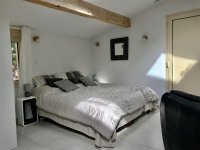Saint-Martin-de-Londres
The partners of the Tourist Office du Grand Pic Saint-Loup in Saint-Martin-de-Londres :

The village of Saint-Martin-de-Londres has one of the best preserved Romanesque monuments in the Languedoc region in the form of its church, which is hidden behind a medieval wall halfway between Montpellier and the Cévennes.
In the 11th century, the Romanesque art that spread in Languedoc was characterised by a strong Lombard influence.
In the Hérault, at Saint-Martin-de-Londres, it is evident in the church built at the beginning of the century by the monks of the abbey of Saint-Guilhem-du-Désert on one of the routes to Santiago de Compostela (the Arles route). A historic monument, it never ceases to intrigue: why such a masterpiece of architecture, such a wealth of ornamentation, in this small village? The long and fascinating history of the church is worth a visit. The building is set in a fortified enclosure against which are built houses of character.
The "first Romanesque art" bursts out in its simplicity and harmony on the walls of the church. Inside, the architecture is in keeping with the period, but shows imagination (trefoil plan, dome, sculpted decoration). A second, later enclosure is built on top of the first, delimiting the medieval village to the south with its characteristic houses.
Wander through the narrow streets and descend to the square shaded by hundred-year-old plane trees, then linger by the fountain.
What is the origin of "London"?
In Celtic times, Llyn dinas, which became the city of London, was the name of the "hill of the pond" for our English neighbours. In Languedoc, Loundro would have meant "mud, stagnant water" and the terms Lundras, Lundrias, Doundras, which after mutation gave London, were used in medieval writings to characterise our now dried-up valley. Nevertheless, it is often drowned in the mist that escapes from the land that was once overgrown by marshes.
Mairie de Saint-Martin-de-Londres
Adresse: 9 place de la mairie
04 67 55 00 10
Mail
Site Internet
Facebook
Heritage and culture in Saint-Martin-de-Londres
- Le Réseau Vert®, de Notre-Dame-de-Londres à Roussières
- Romanesque church of Saint Martin (XIᵉ century)
- Caves and caves, dolmen, prehistoric stations, tumuli
- Aven with clay drawing
- Ramparts (XIIᵉ and XVᵉ century)
- Font Termenau
- Bertrand Mill
- Hydroelectric dam
- Festi'Val de Londres (July)
33 resultsSort









































